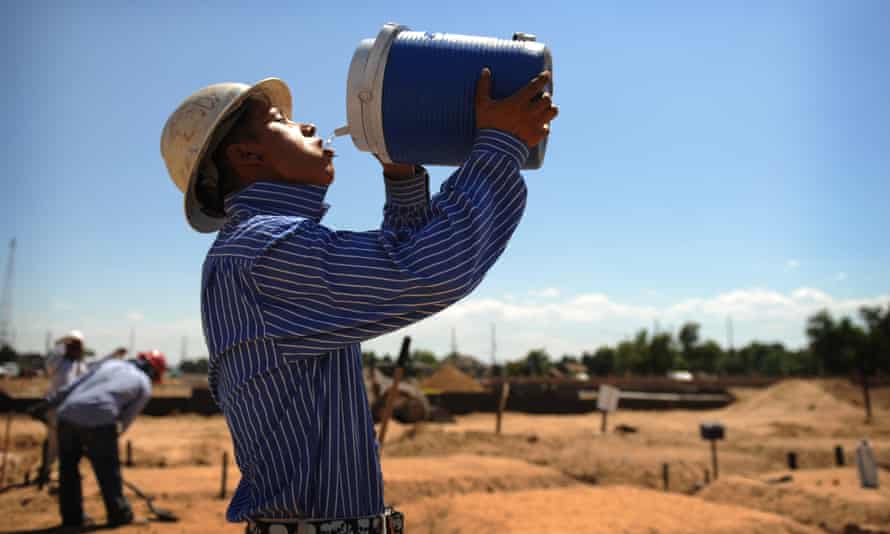Too hot to work: the dire impact of extreme heat on outdoor US jobs
By 2050, nearly 60% of outdoor workers could experience at least one week when extreme heat makes it too dangerous to work if little to no action is taken

In the next few decades, Americans who work outdoors could increasingly find that it is simply too hot to do their jobs without risking their health.
By 2050, nearly 60% of outdoor workers – such as construction workers, emergency responders and farmworkers – could experience at least one week of workdays when extreme heat makes it too dangerous for them to work. This is in a scenario where little to no action is taken to reduce emissions. Currently less than 10% of outdoor workers lose work days to extreme temperatures.
“If we don’t reduce our heat-trapping emissions, millions of outdoor workers are going to be increasingly exposed to dangerous levels of heat between now and the middle of the century,” said Kristina Dahl, co-author of a new report published today by the Union of Concerned Scientists.
Remarkably, nearly one in five outdoor workers would experience at least a month of these scorching days.
About a fifth of American workers – or 32 million people – currently have outdoor occupations where a large part of their day is spent outside.
Outdoor workers in the US face up to 35 times the risk of dying from heat exposure than the general population. The Centers for Disease Control and Prevention (CDC) recommends employers reduce work schedules when the heat index – which accounts for heat and humidity – reaches 100F (38C) to 108F (42C). There are currently no federal heat-safety standards that protect outdoor workers during extreme heat, and only two states, California and Washington, have permanent heat standards for outdoor workers’ safety.
Staying home on hot days would ultimately cost an average outdoor worker about $1,700 each year – amounting to $55bn annually for all outdoor workers.
The most severe impacts will be on construction and extraction workers in fields like mining, who risk losing $14.4bn in earnings annually, followed by installation, maintenance and repair occupations, who could lose about $10.8bn.
Southern states will face the largest number of days when working outside is all but impossible. In Louisiana, for example, workers already lose about $1,000 in wages because of days when it’s too hot to work. That figure could increase to nearly $5,000 due to 34 days worth of lost work time annually.
People of color will be hit especially hard by extreme heat. People who identify as African American, Black, Hispanic or Latino are disproportionately represented in outdoor work, comprising about 40% of the outdoor workforce despite making up only 32% of the US population in general.
“We have groups of people who are already experiencing systemic racism in the US and extreme heat has the potential to really exacerbate the existing inequities that they’re facing in society,” Dahl said.
In addition, Black and Latino Americans are more likely to live in the hard-hit southern states.
While some workplaces, like construction companies, are moving their work hours to earlier in the day, there are tradeoffs.
“Shifting work to nighttime hours has been associated with higher levels of mental and physical health problems,” Dahl said.
Yet not everyone will be able to alter their working hours.
“Emergency medical services can’t just shift to cooler hours of the day,” Dahl said. “If you’re a parent and you have children who need to get to school at 8.30 and your shift starts at 6 rather than 8 as it did before, it becomes a lot harder to get to work and get your kids to school.”
Earlier this year, congressional Democrats introduced a bill mandating the Occupational Safety and Health Administration to require that employers provide adequate water, shade and rest breaks for outdoor workers regularly exposed to heat – similar to worker protections that already exist in California. The bill is named after Asuncion Valdivia, a California farmworker who died from heatstroke in 2004 after picking grapes for 10 hours straight in 105F temperatures.
Many of these efforts could help workers, but Dahl said it is important to focus on the core cause.
“Our first line of defense still needs to be reducing carbon emissions,” Dahl said.
